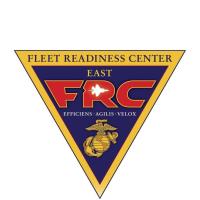Fleet Readiness Center East (FRCE) met a new milestone with the induction of its first Navy CMV-22B Osprey for maintenance Aug. 21. With receipt of this aircraft, the depot now services all three variants of the V-22 platform, which also include the Marine Corps MV-22B and the Air Force CV-22.
The CMV-22B is the newest member of the Osprey family, entering service in June 2020 on the West Coast and April 2024 on the East Coast. In comparison, the Marine Corps MV-22B Osprey has been in use since achieving initial operational capability in 2007, and the Air Force CV-22 variant has been in operational use since 2009. FRCE will take on responsibility for the Navy’s East Coast-based CMV-22B fleet.
FRCE Commanding Officer Capt. Randy J. Berti said the new workload comes in as a direct result of the quality workmanship the command is known for across the board.
“FRC East’s maintenance of all three variants of the V-22 Osprey, for three different branches of the U.S. Armed Forces, really highlights the reputation for excellence our artisans, engineers and support staff have built,” Berti said. “I couldn’t be more proud that the Navy is entrusting us with this new mission. Every day, our workforce strives to provide high-quality service to the fleet at the best possible cost, and our success in that effort leads to the mutual trust and respect we have with our customers – our nation’s warfighters. The work we do here makes a real-world difference for them.”
The Navy is fielding the CMV-22B for long-range, medium-lift aerial logistics capabilities, including the carrier onboard delivery (COD) mission. Like all V-22 aircraft, the tiltrotor, vertical/short takeoff and landing aircraft can take off and land as a helicopter but transit as a turboprop aircraft, and is capable of shore-based, “expeditionary” or sea-based operations. Its features include an extended operational range compared to the MV-22B, and the aircraft offers increased mission flexibility over the Navy’s legacy C-2A Greyhound, which it is replacing.
FRCE V-22 Branch Head Allen Williamson said the depot will provide Planned Maintenance Interval (PMI) 1 service to the CMV-22B aircraft. He anticipates the work scope will closely mirror the PMI-1 evolutions already performed on the MV-22B, which the depot has serviced since 2009, at Marine Corps Air Stations Cherry Point and New River, and the Air Force CV-22 variant at FRCE’s detachment at Hurlburt Field, Florida.
“While the CMV-22B does have some additional capabilities, the maintenance specifications largely remain the same between the Navy and Marine Corps variants of the Osprey,” he said. “The CMV-22B aircraft is structurally identical to the MV-22B, with the exception of the stub wing fuel tanks. Those tanks on the Navy aircraft are actually quite a bit larger, to provide that extra flight range needed for carrier delivery operations.
“There are very, very low flight hours on these initial CMV-22 aircraft we’ll be receiving, so they’re essentially in new condition,” Williamson continued. “We presume the work scope is going to build in the future, based on the theater they’ll be operating in. The Navy has indicated they plan to deploy the aircraft on ships, which is a harsh environment, and they will be high-use aircraft. With that in mind, I believe there will be a learning curve in regard to what condition we can expect to see these aircraft in as they come in for maintenance in the future, based on the environmental factors.”
Williamson said his guidance to the artisans on the production line is to approach the CMV-22B maintenance as if it were a new capability, rather than an extension of the familiar workload. This will give the team the opportunity to look at the aircraft and its needs with fresh eyes, rather than with preexisting expectations, he added.
“Obviously, the instructions should marry over fairly well – everything, we presume, is the same,” Williamson explained. “But especially with this first aircraft, we’re emphasizing to the team that they should take their time and really explore whether there are any additional differences in the aircraft itself, of the way we work it versus how we would work an MV.”
At the moment, Williamson said, the biggest difference in CMV-22B depot-level maintenance appears be the aircraft’s paint job – the newer variant uses a different type of paint than the standard MV-22B and, as a Navy aircraft, has different markings than the Marine Corps version.
“The aircraft uses a high-gloss paint, so the prep and the application are going to be a little bit different than what we’re used to with the standard MV-22B,” said Paint and Clean Branch Head Matt Sinsel. “There will be some differences in the masking process, because the paint scheme is a little higher-profile than the standard grey Ospreys.
“Spraying high gloss is nothing new for the our team; we do it with the Marine Helicopter Squadron 1 Ospreys, and we do it with the white-top H-1 helicopters for the Air Force, and the State Department H-46 helicopters,” he added. “But there will be some differences, and there will be some learning involved.”
Sinsel said the unique paint scheme of the CMV-22B also gives his team another opportunity to use the laser projection system the depot began using in January to streamline the final finish process, during which an aircraft’s insignia and other markings are applied to the finished base paint. The system acts as a guide for the precise placement of the markings without having to use paper stencils.
Despite the anticipated challenges that come along with learning the ins and outs of maintaining a new aircraft – even one so similar to familiar products – leaders believe the new workload offers FRCE a chance to shine by rounding out its support of the entire V-22 family.
“The V-22 program at FRCE has received its accolades,” Williamson said. “We’re known for what we do, and not just within the brick-and-mortar site at Cherry Point. We have our detachment at New River, which is revered in its own light for the way they conduct a PMI. We have the In-Service Repair team down at New River that is making depot-level repairs while embedded with the Marine squadrons. And we have Hurlburt Field, where we support Air Force Special Operations Command. This isn’t a totally new workload, but it adds a new capability.
“I don’t think the Navy would have considered us for the CMV-22 workload if we didn’t have that track record of superior performance with the products we return to the fleet, and didn’t have the good rapport that we already have with our current customers,” he continued. “I think this is a chance for us to succeed. This is an opportunity to show the Navy that we own the maintenance process on the MV-22s, now let us keep this CMV business for a while and show them our success in providing the fleet with a quality product that we know is going to make that next flight window with no issues.”
FRCE is North Carolina's largest maintenance, repair, overhaul and technical services provider, with more than 4,000 civilian, military and contract workers. Its annual revenue exceeds $1 billion. The depot provides service to the fleet while functioning as an integral part of the greater U.S. Navy; Naval Air Systems Command; and Commander, Fleet Readiness Centers.
-
John Olmstead Public Affairs Officer
- November 12, 2024
- 252-464-9111
- Send Email



